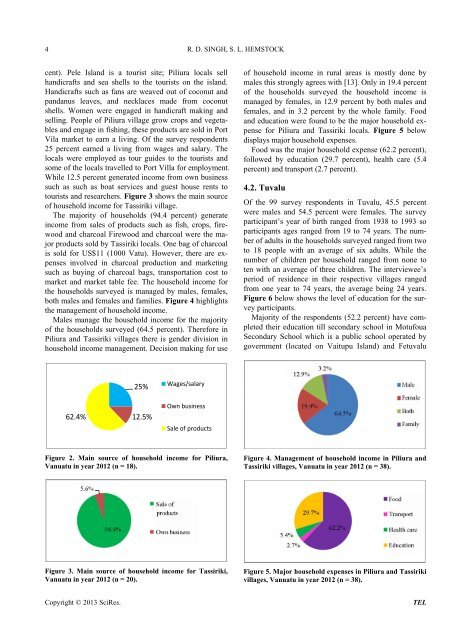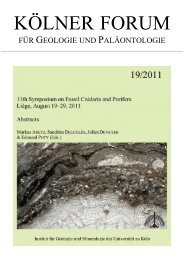Full-Text PDF - Scientific Research Publish
Full-Text PDF - Scientific Research Publish
Full-Text PDF - Scientific Research Publish
Create successful ePaper yourself
Turn your PDF publications into a flip-book with our unique Google optimized e-Paper software.
4<br />
R. D. SINGH, S. L. HEMSTOCK<br />
cent). Pele Island is a tourist site; Piliura locals sell<br />
handicrafts and sea shells to the tourists on the island.<br />
Handicrafts such as fans are weaved out of coconut and<br />
pandanus leaves, and necklaces made from coconut<br />
shells. Women were engaged in handicraft making and<br />
selling. People of Piliura village grow crops and vegetables<br />
and engage in fishing, these products are sold in Port<br />
Vila market to earn a living. Of the survey respondents<br />
25 percent earned a living from wages and salary. The<br />
locals were employed as tour guides to the tourists and<br />
some of the locals travelled to Port Villa for employment.<br />
While 12.5 percent generated income from own business<br />
such as such as boat services and guest house rents to<br />
tourists and researchers. Figure 3 shows the main source<br />
of household income for Tassiriki village.<br />
The majority of households (94.4 percent) generate<br />
income from sales of products such as fish, crops, firewood<br />
and charcoal Firewood and charcoal were the major<br />
products sold by Tassiriki locals. One bag of charcoal<br />
is sold for US$11 (1000 Vatu). However, there are expenses<br />
involved in charcoal production and marketing<br />
such as buying of charcoal bags, transportation cost to<br />
market and market table fee. The household income for<br />
the households surveyed is managed by males, females,<br />
both males and females and families. Figure 4 highlights<br />
the management of household income.<br />
Males manage the household income for the majority<br />
of the households surveyed (64.5 percent). Therefore in<br />
Piliura and Tassiriki villages there is gender division in<br />
household income management. Decision making for use<br />
of household income in rural areas is mostly done by<br />
males this strongly agrees with [13]. Only in 19.4 percent<br />
of the households surveyed the household income is<br />
managed by females, in 12.9 percent by both males and<br />
females, and in 3.2 percent by the whole family. Food<br />
and education were found to be the major household expense<br />
for Piliura and Tassiriki locals. Figure 5 below<br />
displays major household expenses.<br />
Food was the major household expense (62.2 percent),<br />
followed by education (29.7 percent), health care (5.4<br />
percent) and transport (2.7 percent).<br />
4.2. Tuvalu<br />
Of the 99 survey respondents in Tuvalu, 45.5 percent<br />
were males and 54.5 percent were females. The survey<br />
participant’s year of birth ranged from 1938 to 1993 so<br />
participants ages ranged from 19 to 74 years. The number<br />
of adults in the households surveyed ranged from two<br />
to 18 people with an average of six adults. While the<br />
number of children per household ranged from none to<br />
ten with an average of three children. The interviewee’s<br />
period of residence in their respective villages ranged<br />
from one year to 74 years, the average being 24 years.<br />
Figure 6 below shows the level of education for the survey<br />
participants.<br />
Majority of the respondents (52.2 percent) have completed<br />
their education till secondary school in Motufoua<br />
Secondary School which is a public school operated by<br />
government (located on Vaitupu Island) and Fetuvalu<br />
62.4%<br />
25%<br />
12.5%<br />
Wages/salary<br />
Own business<br />
Sale of products<br />
Figure 2. Main source of household income for Piliura,<br />
Vanuatu in year 2012 (n = 18).<br />
Figure 4. Management of household income in Piliura and<br />
Tassiriki villages, Vanuatu in year 2012 (n = 38).<br />
Figure 3. Main source of household income for Tassiriki,<br />
Vanuatu in year 2012 (n = 20).<br />
Figure 5. Major household expenses in Piliura and Tassiriki<br />
villages, Vanuatu in year 2012 (n = 38).<br />
Copyright © 2013 SciRes.<br />
TEL
















